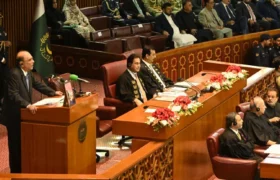From Guns to Roses the story of Erstwhile FATA (Part-I)
By Kashmala Yousafzai
Federally Administered Tribal Areas Federally Administered Tribal Areas, once called, have become part of Khyber Pukhtunkhwa province.
The journey from the tribal areas to the districts of Khyber Pakhtunkhwa seems to be a distance of 74 years, but in fact, it is the result of ever-changing social and developmental changes, not knowing how many centuries it has taken to reach this destination.
Now Khyber, Karam, Orakzai, Mohmand, Bajaur, North Waziristan and South Waziristan are also districts of the province like other parts of the country and neighboring Khyber Pakhtunkhwa. They have also become constituencies.
After the first elections in 2019, 21 seats have also been set up for them. There are 16 common constituencies and 4 reserved seats for women. One seat reserved for the minority. Former agencies in the Khyber Pakhtunkhwa Assembly now have elected members in the form of districts.
All political parties took part in the elections whereas the women were especially enthusiastic. Pakistan Tehreek-e-Insaf, Jamiat Ulema-e-Islam, Balochistan Awami Party won seats. The majority were independent candidates. The participation of political parties in these areas was also a new experience.
In the past, members of the National Assembly and the Senate have always been independents. Apart from these areas of FATA, some tribal areas have remained under the provincial government. They were called PATA (Provincially Administered Tribal Areas). These areas are called districts of Chitral, Dir, Swat, Buner, Shangla, Kohistan, Kala Dhaka and Malakand. Khyber Pakhtunkhwa now consists of a total of 35 districts. The new districts cover an area of 27,220 sq km. Their population is around 5 million. About 7.6 million in PATA districts.
These tribal areas have been playing the role of a security fence for Pakistan. Initially, the government of Pakistan maintained the same rules and regulations and the same arrangements that the rulers of British India had laid down for them. A cursory glance at history reveals that the implementation of the Crime Regulation in these areas began in 1872 when the Punjab Frontier Regulation introduced. The British colonialism took over the area in 1849 after the Second Sikh-British War when it was part of the wider Punjab with Lahore as its capital. Some districts were under regular district administration called Settled Districts. But in the mountainous areas, the British rulers kept their subordinates in terms of politics and security. There was no jurisdiction over the general judicial and administrative system of British India. Most of these tribes had to make their own arrangements under the ‘Pakhtun Wali’. In 1901, the formal FCR was implemented, remained in force after 1947. All the powers of the British Raj were in the hands of a political agent in these areas. The traditional tribal chiefs were called Malik.
The British renamed the permanent border the Durand Line during the reign of Afghan Chief Amir Abdul Rahman Khan. In 1901, the Pakhtun region from Punjab to North West Frontier Province was formed. There were also designated districts and tribal areas. These areas remained the same after the formation of Pakistan in 1947. On June 17, 1947, Quaid-e-Azam Muhammad Ali Jinnah issued a statement expressing gratitude to the Muslims of the tribal areas. He received many letters from tribals, to which he said “it is possible for me to answer them all individually. However, I am deeply grateful to all of them. Who have sent me these congratulatory messages and sincere letters. I especially thank these Muslim brothers in the tribal areas across the border for their good wishes and messages of congratulations. Which were received in large numbers. I want to assure them that we will conduct our affairs in a fraternal manner. We have no desire to interfere in their freedom. We will be happy to meet them and make arrangements that are in the common interest of both us and Muslims in general. ”
Quaid-e-Azam Muhammad Ali Jinnah as the Governor General of Pakistan signed an agreement with the tribal areas and agreed with that Khyber, Kurram, North and South Waziristan agencies not to have Pakistani troops in these areas. The post of political agent also remained. The jurisdiction of the high courts of Pakistan was also not in these areas. They were called independent area. The situation remained the same till 1970, but then, due to economic needs, the desire of the people of erstwhile FATA to get employment opportunities in Pakistan and abroad began to grow.
With the establishment of Pakistan and beyond, the elders of the tribal areas insisted on maintaining their special status, culture and environment forever and in respect of these aspirations, like other parts of Pakistan, legal authority was avoided but in the wake of September 2001, 9/11 the situation in the region changed and the war on terror began. In view of the threats of terrorism and extremism, the tribal people and elders also changed their minds that development and prosperity in the tribal areas is equally important. As is happening in other parts of the country. Thus, the tribal areas were transformed into tribal districts according to the wishes of their people and elders.
The situation has changed rapidly since 1971. The secession of the big wing after the Indian aggression in East Pakistan, the adoption of the 1973 constitution, the uprising of Sardar Dawood Khan in Afghanistan, the Russian intervention in Afghanistan since 1978.
From here, the importance of the tribal areas increased rapidly because of the civil war in Afghanistan, the Soviet invasion, the interest of the United States, Europe and Arab countries, a large number of Afghan refugees began to enter these tribal areas. Russia’s defeat, Afghans’ own government, then the rise of the Taliban. All these incidents were having a direct impact on the tribal areas. Security, law and order issues were getting serious there. The system of political agents was failing to meet the administrative, economic and legal needs there.




